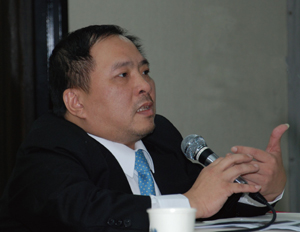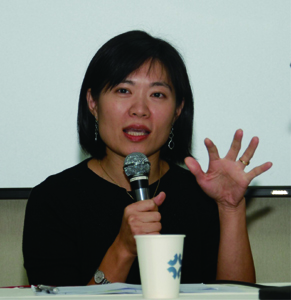LED Lighting Makers Share How-to Strategies
2011/01/10 | By Ken LiuNeo-Neon’s Taipei office manager believes retail distribution is critical

At a forum addressing LED (light emitting diode) lighting applications held recently in Taipei, both speakers, Randy Cheng and general manager of Neo-Neon Holding Ltd.’s Taipei office and Milla Wu, general manager of Lightron Technology Corp. (LTC), felt that price continues to hobble LED lighting from becoming significantly more popular and advised peers to develop smart strategies to overcome such downside.
Cheng believes it’s imperative for LED lighting-fixture manufacturers to be frontline educators, enlightening consumers on LED lighting applications, while the most feasible way is to set up distribution channels. Wu urges lighting manufacturers to offer enterprises considering replacing energy-wasting lights with LED counterparts convincing data on electricity consumption, high-quality lighting fixtures and merit-worthy LED lighting projects.
Cheng says that if LED lighting manufacturers do not set up distribution channels now, market entry in the future will be a steep uphill battle. “People see the lucrative potential of the LED-lighting market, but not the lurking danger due to extreme non-uniformity in the lighting market. The reality is the LED lighting market is harder to predict than the traditional lighting market due to various technical bottlenecks. Without setting up distribution channels, makers will stumble to predict market trends. With Neo-Neon running scheduled production, it’s inevitable for the company to set up retailers to stay well informed of the market.”
Clear Market Positioning
However, Cheng stresses that LED lighting makers need clear market positioning before setting up distribution channels for the market is extremely non-uniform not only in quality but also pricing. Vague market positioning will easily cause makers to flounder in the long run, he says. Driving the point home, Cheng says that Neo-Neon, determined to focus on retailing, has shipped over 5,000 products for commercial, residential, indoor, outdoor and DIY-project lighting to over 4,000 retailers in over 100 countries, including Home Depot, Target, Canadian Tire and B&Q (Taiwan). “Neo-Neon is probably unmatched in the retail market in terms of product line, but with a quite limited presence in the lighting-project market, which defines our market position,” Cheng says.
Without uniformity in the market, Cheng says, makers find dealing with price elusive, hampering sales growth after achieving certain goals. Makers can usually develop smart LED lighting products, but not popularly priced products, adds Cheng. LED lighting is relatively costlier, especially with LED chip production that accounts for 60-70% of lighting manufacturing cost. Neo-Neon, for instance, spends US$3.5 million a month in production.
Neo-Neon is known for setting up integrated manufacturing to reduce production cost, having been aggressively building such capacity since it branched into LED lighting manufacturing in 2000 from traditional lighting that was begun in 1979. With in-house epitaxy-wafer, chip-making, packaging, and lighting-module facilities, Neo-Neon’s major revenue earner is LED lighting rather than mini incandescent bulbs.

Cheng stresses that makers find it inevitable to set up integrated manufacturing once critical mass is reached in production scale. “Your enormous scale may be outsized by production capacities, while outsourcing involves quality inconsistency worries associated with signing up contractors.” Neo-Neon runs four metal organic chemical vapor deposition (MOCVD) chambers at its headquarter factory in Heshan, Guangdong Province to turn out 30,000 2-inch epitaxy wafers a month, around the size of a second-tier epitaxy-wafer maker in Taiwan.
Duplicating Success
The company’s integrated LED capability duplicates its success in mini-bulb manufacturing. Cheng says that in the heyday of the company’s mini-bulb production, numbering eight million units per month, the company even made tungsten filaments, electrical cables and plastic parts in-house. “Before starting to make plastic components in-house, we used to be one of Nan Ya Plastics’ major customers of PVC products in Asia. Nan Ya even opened a one-man company in Hong Kong dedicated to our company. But we started in-house production because Nan Ya could not offer lower prices as requested,” Cheng says.
Neo-Neon estimates that integrated manufacturing slashed the cost of mini-bulb manufacturing by 90% to outdo rivals to lead the world in the segment by 2000, with the same approach reportedly reducing 70% of its LED-lighting manufacturing costs.
LTC is noted for working with several peers in Taiwan to promote the island’s LED lighting brands globally. The company is adept at designing eco-friendly lights for lighting projects, with LED lamps usually being key components. So far, the company has completed lighting projects for an apartment building in Banchiao, a park in Nanshijiao of New Taipei City, and a Taoist temple in Hsinchu County, an hour away by car north of Taipei.
Wu says that LTC has had to meet similar specifications for each LED lighting project: unique design, energy-efficiency, easy maintenance and cost-effectiveness, all of which can be met except the last. However, she says that many general contractors and owners are more willing to accept LEDs now than before due to extremely long lifespan measured in tens of thousands of hours, low maintenance cost, varying light color and energy-efficiency.
Persuade With Data
“But how to convince price-conscious consumers to accept LEDs for interior d?cor projects depends on lighting designers, who are obliged to sell LEDs to end users. I typically offer three persuasive points: concrete data on LED lighting performance, high quality lighting fixture and imminent dominance in the near future,” Wu says.
Lighting designers should offer data comparing halogen lamp with LED lamp and note that the two light sources are similar in color rendering, but LEDs excel in energy efficiency and color variation, says Wu.
On promoting the quality of lighting fixtures, Wu suggests that lighting designers ask fixture manufacturers for various data, including luminous efficacy, voltage and wattage of power drivers, lifespan tests, properties, and color temperatures, without which users will have grounds leading to doubt.
LEDs will become a trendy light source in the near future due to declining cost, improving LED efficacy and unquestionable eco-friendly merits. Though not the sole replacement for incandescent bulbs, LEDs outperform fluorescent lamps and organic LEDs in lifespan, energy-efficiency, brightness and thermal dissipation, also emitting zero ultraviolet radiation and being flicker-free, according to Wu.
Besides good quality, energy-efficiency, design and pricing, Wu believes that LEDs also need to be easy-to-install, a design criteria critical to successfully draw consumers, especially when the replacement market for incandescent bulbs is huge.

